
Share
Here’s Why You Should Switch from Coffee to Matcha
The Energy Difference: Sustained Focus vs Quick Highs
While both coffee and matcha contain caffeine, their effects on your body differ significantly. Coffee typically delivers a quick surge of energy, often followed by a noticeable crash. This roller coaster can leave you reaching for another cup by mid-afternoon. Matcha, on the other hand, contains L-theanine, an amino acid that works synergistically with caffeine to provide a sustained release of energy.
This unique combination creates what many describe as "calm alertness" – you're focused and energized, but without the jitters or anxiety that coffee might induce. The energy from matcha typically lasts 4-6 hours, compared to coffee's 2-3 hours, and the descent is gentle rather than abrupt.
Gentler on Your System
For many coffee drinkers, that morning cup can trigger acid reflux or stomach discomfort. Matcha's alkaline nature makes it significantly gentler on your digestive system. Its preparation without steeping also means you're consuming the whole tea leaf, providing a rich source of fiber that can help stabilize the caffeine absorption.

A Nutritional Powerhouse
While coffee certainly has its health benefits, matcha is exceptionally nutrient-dense. When you drink matcha, you're consuming the entire tea leaf, which means you get the full benefit of its nutritional profile:
Antioxidants: Matcha contains catechins, particularly EGCG, at concentrations far higher than regular green tea
Chlorophyll: Gives matcha its vibrant colour and helps with detoxification
L-theanine: Promotes relaxation without drowsiness
Vitamins and minerals: Including vitamin C, zinc, magnesium, and chromium
The Ritual of Preparation
Making matcha can become a mindful morning practice. While coffee preparation often focuses on speed and convenience, preparing matcha invites you to slow down. The process of measuring the powder, adding water at the right temperature, and whisking to create the perfect froth becomes a moment of mindfulness in your day.

Environmental Considerations
From a sustainability perspective, matcha often has a smaller environmental footprint. The tea plants are shade-grown, requiring less water than coffee plantations, and the processing is typically less resource-intensive. One tin of matcha can replace numerous coffee pods or paper filters, reducing waste.
Making the Transition
If you're interested in making the switch, start gradually. You might begin by replacing your afternoon coffee with matcha, allowing your body to adjust to the different type of energy it provides. Pay attention to how you feel – many people report improved focus, fewer energy crashes, and better sleep when they make the switch.
Tips for Getting Started:
- Start with a high-quality matcha for the best experience
- Experiment with different preparations (hot, iced, lattes)
- Invest in proper tools for preparation
- Be patient as you develop your taste for matcha's unique flavour profile
While coffee will always have its place in our hearts and routines, matcha offers a compelling alternative for those looking to refine their daily energy ritual. Its unique combination of sustained energy, health benefits, and versatility makes it worth considering as your new daily companion.
Whether you're seeking more stable energy levels, looking to reduce acid intake, or simply curious about exploring a new daily ritual, matcha provides an excellent alternative to traditional coffee. The switch doesn't have to be all-or-nothing – many people find that having both options in their repertoire allows them to choose the best beverage for their needs at any given moment.